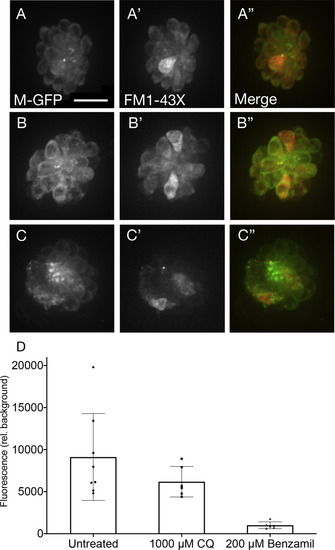Fig. 3
- ID
- ZDB-FIG-200812-15
- Publication
- Davis et al., 2020 - Chloroquine kills hair cells in zebrafish lateral line and murine cochlear cultures: Implications for ototoxicity
- Other Figures
- All Figure Page
- Back to All Figure Page
|
Chloroquine does not reduce MET channel activity. Fluorescent imaging showed no reduction of FM1-43-X uptake with pre-exposure to chloroquine (A–C). Brn3c fish, that have green fluorescent membrane markers, had no pre-treatment (A–A”), 1000 μM chloroquine for 15 min (B–B”), or 200 μM benzamil for 15 min (C–C”). Dunn’s multiple comparisons confirmed that red fluorescence is not significantly attenuated in fish pre-treated with a high dose of chloroquine (p = 0.2334), while uptake is significantly lower in those fish treated with benzamil (p < 0.0001), a known MET channel blocker (D; n = 6–8 fish per condition). Error bars represent ±1 standard deviation. Scale bar = 10 μm. (For interpretation of the references to colour in this figure legend, the reader is referred to the Web version of this article.) |
Reprinted from Hearing Research, 395, Davis, S.N., Wu, P., Camci, E.D., Simon, J.A., Rubel, E.W., Raible, D.W., Chloroquine kills hair cells in zebrafish lateral line and murine cochlear cultures: Implications for ototoxicity, 108019, Copyright (2020) with permission from Elsevier. Full text @ Hear. Res.

